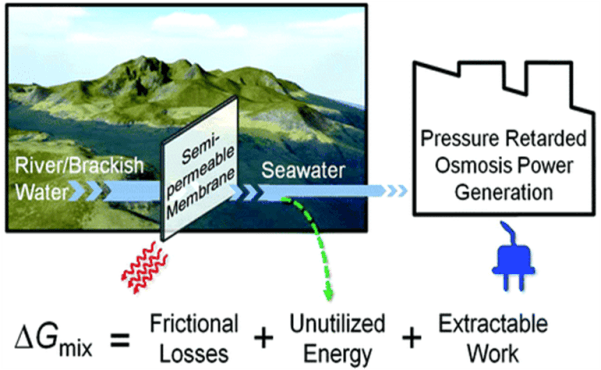As they surge into the sea, our mighty rivers could produce enough power to meet the electricity needs of 520 million people per year, say researchers at Yale University.
As one of the most abundant resources, ocean energy receives plenty of attention. Several impressive projects are happening around the world (wave energy test centers in Scotland and Hawaii, tidal turbines in India and New Zealand, wave power and desalination in Australia). But let us not forget our freshwater friends. Rivers discharge about 37,000 cubic kilometers of freshwater into the sea each year. A special interaction occurs when freshwater mixes with seawater—the difference in salt concentrations produces energy. Recent advances have enabled cost-effective ways to capture the osmotic power for consumer use.
image via ShutterstockA promising technique for harnessing osmotic power is called pressure retarded osmosis. In this method, river water is driven into the salty seawater draw solution by the difference in osmotic pressure across a semipermeable membrane. When hydraulic pressure less than the osmotic pressure is applied to the seawater side, the flow of freshwater across the membrane is slowed. A hydroturbine can extract the energy created by the expanding draw solution volume, and the energy can be used to generate electricity for homes and businesses.
In a recently published article in the journal Environmental Science & Technology, Yale researchers Ngai Yin Yip and Menachem Elimelech analyzed the thermodynamic and energy efficiency of power generation by pressure retarded osmosis. They determined that maximum efficiency and cost-effectiveness require a high membrane power density. The power produced per membrane area is best with “high performance membranes—active layer with high water permeability and salt selectivity, coupled with customized support layer that suppresses the detrimental effect of internal concentration polarization.” Membrane technology has only recently become advanced enough to be considered affordable in real-life scenarios.
Elimelech was scheduled to chair a session and present his research on high-performance thin-film composite membranes at the Third Annual Osmosis Membrane Summit last week. Several other new membrane types were discussed when industry scientists gathered to share information at the two-day event in Barcelona.
Related presentations included results from Japan’s Mega-Ton Water System and Norway’s pressure retarded osmosis prototype power plant (the world’s first), by Statkraft, Europe’s largest renewable energy company. Statkraft recently announced plans to collaborate with Hydro-Québec to study the effects of freshwater pretreatment technologies in osmotic power plants. Pretreatment is often necessary to prolong membrane life expectancy and to reduce fouling.

An efficient pressure retarded osmosis system could generate 157 GW of renewable power annually, meeting the electricity needs of over half a billion people, using just one tenth of the global river water discharge. Producing that same amount of energy in a coal-fired plant would emit over one billion metric tons of greenhouse gases.
As water shortages persist due to industrial development and population growth, researchers strive to find the best ways to take advantage of the ocean’s unlimited energy. Pressure retarded osmosis requires no fuel and releases no carbon dioxide. Though considered expensive, historically, novel technologies show promise for affordable applications. Stay tuned to EarthTechling for all the latest news.